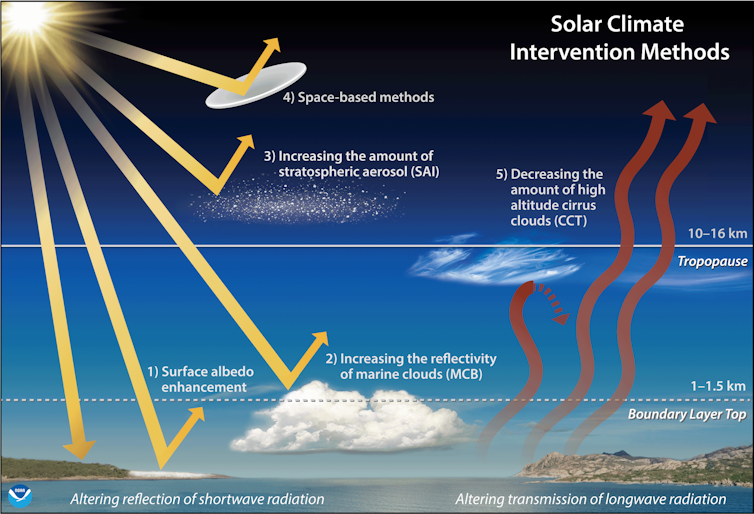By David Kitchen, University of Richmond

When soaring temperatures, extreme weather and catastrophic wildfires hit the headlines, people start asking for quick fixes to climate change. The U.S. government just announced the first awards from a $3.5 billion fund for projects that promise to pull carbon dioxide out of the air. Policymakers are also exploring more invasive types of geoengineering − the deliberate, large-scale manipulation of Earth’s natural systems.
The underlying problem has been known for decades: Fossil-fuel vehicles and power plants, deforestation and unsustainable agricultural practices have been putting more carbon dioxide into the atmosphere than the Earth’s systems can naturally remove, and that’s heating up the planet.
Geoengineering, theoretically, aims to restore that balance, either by removing excess carbon dioxide from the atmosphere or reflecting solar energy away from Earth.
But changing Earth’s complex and interconnected climate system may have unintended consequences. Changes that help one region could harm another, and the effects may not be clear until it’s too late.
As a geologist and climate scientist, I believe these consequences are not yet sufficiently understood. Beyond the potential physical repercussions, countries don’t have the legal or social structures in place to manage both its use and the fallout when things go wrong. Similar concerns have been highlighted by the Intergovernmental Panel on Climate Change, the United Nations Environment Programme, the National Academy of Sciences and the National Oceanic and Atmospheric Administration, among others.
The White House Office of Science and Technology Policy also discussed these concerns in its July 2023 research plan for investigating potential climate interventions.
Risks of solar radiation management
When people hear the word “geoengineering,” they probably picture solar radiation management. These technologies, many of them still theoretical, aim to reflect solar energy away from Earth’s surface.
The idea of stratospheric aerosol injection, for example, is to seed the upper atmosphere with billions of tiny particles that reflect sunlight directly out to space. Cirrus cloud thinning aims to reduce the impact of high-altitude, wispy clouds that trap energy within the atmosphere by making their ice crystals larger, heavier and more likely to precipitate. Another, cloud brightening, aims to increase the prevalence of brighter, lower-level clouds that reflect sunlight, possibly by spraying seawater into the air to increase water vapor concentration.
Some scientists have suggested going further and installing arrays of space mirrors that could reduce global temperature by reflecting solar energy away before it reaches the atmosphere.

Chelsea Thompson, NOAA/CIRES
While theoretically capable of cooling the planet, solar radiation management could have drastic side effects by shifting patterns of global atmospheric circulation that can lead to more extreme weather events. It also does nothing to reduce harms of excess greenhouse gases, including ocean acidification. A 2022 study published in the scientific journal Nature predicted that stratospheric aerosol injection could alter global precipitation patterns and reduce agricultural productivity.
Cloud brightening, while effective in theory, also needs more research to make sure that efforts to expand lower-level reflective clouds that can help cool Earth’s surface do not also increase the prevalence of the high-altitude clouds that warm the planet.
Space mirrors placed between the Sun and Earth could theoretically block 2% of incoming solar radiation and stabilize global temperature. But the technology is at least 20 years away from implementation and would cost trillions of dollars. More importantly, the overall global impact of shading Earth’s surface is largely unknown. It will decrease regional ocean and air temperatures in ways that may affect changes in the jet stream, rainfall, snow cover, storm patterns and possibly even monsoons. Much more research is needed to clarify these uncertainties.
Removing carbon dioxide from the air
Carbon dioxide removal technologies generally carry lower risks than manipulating solar energy.

Carbon capture and storage removes carbon dioxide from power plants and factories and stores it underground in deep geological reservoirs. This has proven potential, but it raises concerns that leaks might contaminate aquifers, harm public health and ultimately fail to keep carbon out of the atmosphere.
The technology is also expensive and depends on the proximity of suitable reservoirs for storage.
Direct air capture, designed to pull carbon out of the air, is still in its early stages but offers the advantage of being able to reduce existing levels of carbon dioxide in the atmosphere. This, too, is costly, at upward of $600 per metric ton of carbon dioxide captured today, but innovators are getting funding from the U.S. government.
There are also natural ways to remove carbon. Planting trees, for example, can remove carbon directly from the atmosphere, but this is not enough. If all the land available for reforestation were replanted, it would still not be enough to reverse current global warming trends.
Ocean fertilization is another geoengineering hack intended to boost carbon sequestration, but research is at an early stage. The technique provides nutrients such as iron to increase the growth of phytoplankton, which use dissolved carbon from the atmosphere to grow their shells and tissue. But it may also have unintended effects for the food chain that could harm ocean life.
The legal void
Beyond safety, another important question involves accountability.
There’s a good chance that geoengineering meant to help one region would harm others. That’s because ocean and weather systems are globally interconnected.
So, who gets to decide which projects can go ahead? Right now, that’s a legal void.
There is no regulatory framework that can determine who is liable if something goes wrong. Multinational alliances, individual states, corporations and even rich individuals can act independently without consulting anyone. In the event of harm that crosses national boundaries, there is currently no clear path for recourse.
Striking the right balance
None of this is to say that the world should dismiss geoengineering.
Carbon dioxide removal techniques, such as planting trees and increasing soil carbon sequestration – retaining more organic carbon in fertile soils – may provide additional benefits to ecosystem services by increasing species diversity and boosting agricultural productivity. These are all positive outcomes and should be part of a global climate response.
Some forms of stratospheric aerosol injection might avoid the destruction of ozone and have short life spans in the atmosphere. However, more rigorous research, transparent global governance and robust legal and ethical frameworks to manage risks and ensure equity are needed first.
I believe all the technologies must be complemented by deep and sustained efforts to reduce emissions and transform the energy system to avoid the global impacts of sea-level rise, soaring temperature, droughts, storms, floods, fires, famine, species extinction and increasing human conflict.
As Riley Duren, a systems engineer from NASA, said in an interview with the space agency: “Geoengineering is not a cure. At best, it’s a Band-Aid or tourniquet; at worst, it could be a self-inflicted wound.”![]()
David Kitchen is an associate professor of geology at the University of Richmond.
This article is republished from The Conversation under a Creative Commons license. Read the original article.
Sign up for The Invading Sea newsletter by visiting here. If you are interested in submitting an opinion piece to The Invading Sea, email Editor Nathan Crabbe at ncrabbe@fau.edu.


